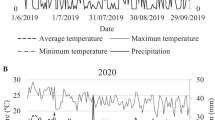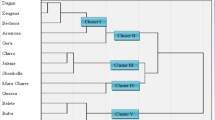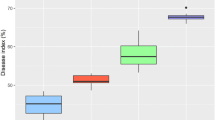Summary
The relationships between disease severity (percent pycnidia of Septoria tritici on the four uppermost leaves) and the vertical disease placement expressed as the ratio between disease height (cm)/plant height (cm), (referred to as SPC (Septoria Progress Coefficient)), and between maturity level (days to heading) and SPC, were evaluated for 9500 wheat and triticale accessions tested in field trials during 1977–1981.
The relation between disease severity and SPC fitted a quadratic equation in which four distinct cutivar response classes were categorized: A) PCD (percent disease)≤15.0/SPC≤0.400 (highly resistant cultivars); B) PCD≤15.0/SPC (0.400–0.650) (moderately resistant); C) PCD (15.0–40.0)/SPC (0.400–0.700) (moderately susceptible); and D) PCD≥40.0/SPC>0.700 (highly susceptible cultivars). It is suggested that cultivars assigned to classes B and C which exhibit low receptivity and moderate to high vertical pathogen placement differ in nature and type of protection from that expressed by the highly resistant cultivars in class A. Representative cultivars belonging to each of the classes are listed together with their agronomic characteristics (plant height and maturity level).
Similar content being viewed by others
References
Anonymous, 1965. Losses in agriculture. U.S. Dept. Agric. Handb. No. 291, 120 pp.
Brokenshire, T., 1976. The reaction of wheat genotypes to Septoria tritici. Ann. Appl. Biol. 82: 415–423.
Browning, J. A., 1979. Genetic protective mechanisms of plant-pathogen populations: Their coevolution and use in breeding for resistance. p. 52–75. In: M. K. Harris (Ed.), Biology and breeding for resistance. Texas A & M University Press, College Station, Texas, Publ. MP-1451. 605 pp.
Danon, T., J. M. Sacks & Z. Eyal, 1982. The relationships among plant stature, maturity class and susceptibility of Septoria leaf blotch of wheat. Phytopathology 72: 1037–1042.
Djerbi, A., A. Ghodbane, A. Daaloul & G. Varughese, 1976. Studies on the Septoria leaf blotch disease of wheat: search for resistance germplasm to Septoria tritici Rob. and Desm. Poljoprivrendo Znanstvena Smotra 39: 137–142.
Eyal, Z., 1981. Integrated control of Septoria diseases of wheat. Plant Disease 65: 763–768.
Eyal, Z., A. Amiri & I. Wahl, 1973. Physiologic specialization of Septoria tritici. Phytopathology 63: 1087–1091.
Eyal, Z. & O. Ziv, 1974. The relationship between epidemics of Septoria leaf blotch and yield losses in spring wheat. Phytopathology 64: 1385–1389.
Eyal, Z. & M. B. Brown, 1976. A quantitative method for estimating density of Septoria tritici pycnidia on wheat leaves. Phytopathology 66: 11–14.
Gough, F. J. & E. L. Smith, 1976. Field reactions of wheat to Septoria leaf blotch. Plant Dis. Reptr. 60: 698–700.
Rosielle, A. A., 1972. Sources of resistance in wheat to speckled leaf blotch caused by Septoria tritici. Euphytica 21: 152–161.
Rosielle, A. A. & A. G. P. Brown, 1979. Inheritance, heritability and breeding behaviour of three sources of resistance to Septoria tritici in wheat. Euphytica 28: 385–392.
Saari, E. E. & R. O. Wilcoxson, 1974. Plant disease situation of high-yielding dwarf wheats in Asia and Africa. Annu. Rev. Phytopathol. 12: 49–68.
Saari, E. E. & J. M. Prescott, 1975. A scale for appraising the foliar intensity of wheat diseases. Plant Dis. Reptr. 59: 377–380.
Shaner, G., R. E. Finney & F. L. Patterson, 1975. Expression and effectiveness of resistance in wheat to Septoria leaf blotch. Phytopathology 65: 761–766.
Shaner, G. & R. E. Finney, 1982. Resistance in soft red wheat to Mycosphaerella graminicola. Phytopathology 72: 154–158.
Shipton, W. A., W. J. R. Boyd, A. A. Rosielle & B. L. Shearer, 1971. The common Septoria deseases of wheat. Bot. Rev. 37: 231–262.
Tavella, C. M., 1978. Date of heading and plant height of wheat varieties as related to Septoria leaf blotch damage. Euphytica 27: 577–580.
Tyagi, P. D., L. M. Joshi & B. L. Renfro, 1969. Reaction of wheat varieties to Septoria tritici and report on an epidemic in North-Western Punjab. Ind. Phytopathology 22: 175–178.
Wilson, R. E., 1979. Resistance to Septoria tritici in two wheat cultivars, determined by independent, single dominant genes. Austral. Plant Pathol. 8: 16–18.
Author information
Authors and Affiliations
Rights and permissions
About this article
Cite this article
Eyal, Z., Wahl, I. & Prescott, J.M. Evaluation of germplasm response to septoria leaf blotch of wheat. Euphytica 32, 439–446 (1983). https://doi.org/10.1007/BF00021453
Received:
Issue Date:
DOI: https://doi.org/10.1007/BF00021453




